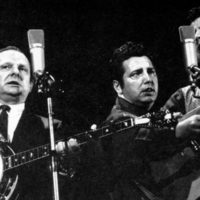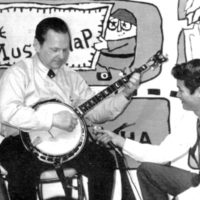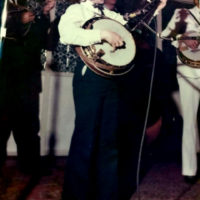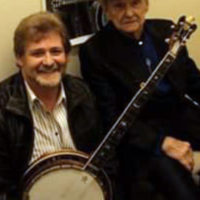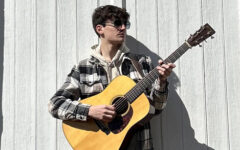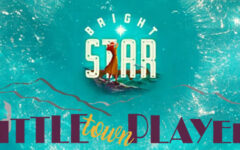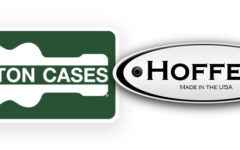
As a young man cutting his teeth on everything “Stanley”, I spent my youth at every Ralph Stanley show I could attend, trying to find every slice of information about Ralph and Carter. In the late ’80s, thanks to Larry Efaw having Ralph at almost every show he hosted, I was able to become quite close with Dr. Ralph. As my family would take vacations to the Blue Ridge Mountains frequently, dad would drop me off at Ralph’s house. Soup beans and cornbread dinners were a regular. My favorite times were riding around the hills of Southwest Virginia with Ralph in his old 4 wheel drive Chevy Luv truck.
Over the years Ralph played many different banjos, most famous is his Deluxe 5 Gibson, or style 5 as he called it, and the numerous Stanleytones he played. In 1987 while my dad and I were at Brady’s Run Park in Beaver, Pennsylvania, I bought a record from Charlie and Doris Chase, two wonderful folks who were at almost every festival with a van full of LP’s. That record was Ralph Stanley Live in Japan. The cover of the album shows Ralph playing a banjo with some strange inlay on the neck, and on the back of the album, a painting of Ralph playing a banjo with an eagle on the headstock. I was puzzled that in 1970 Ralph was not playing his style 5, as it was on almost every recording he made through the mid ’60s through the mid ’70s. It wasn’t long before I made a beeline for Ralph to find out about this strange looking banjo.
Ralph told me that he borrowed the banjo from a fellow around the DC area. While on a trip to Sweden in 1966 with Carter, he took his style 5. The airline had turned the banjo face down in the case, collapsing the bridge, so when the 1970 Japan trip was in the works he felt best to leave his trusty banjo at home and take a borrowed one. He said the eagle banjo sounded really good and was real easy to play. In the early ’90s he said he hadn’t seen the banjo in 20 years, and had no idea what ever became of it. I had thought that the banjo was long gone, never to appear again.
At first glance, one might think that the banjo is a Gibson All American; that’s surely what I thought. It wasn’t until a couple years ago when my Facebook friend Bob Roberts posted a picture of Ralph and the banjo from the 1970 Japan trip that I found out it was not a Gibson. A Gibson All American banjo has an eagle in the headstock just as the banjo Ralph was playing did, only the eagle’s head was turned to the right. On a Gibson, the eagle’s head is turned to the left, as if looking at the person playing. Again the idea of finding the banjo was short lived. In comes my Facebook friend Kristy Richards Westerfield, and the opening of the Bluegrass Hall of Fame in Owensboro, Kentucky.
The opening of the Bluegrass Hall of Fame was an exciting time for us bluegrass folks. A brand new facility, memorabilia from all kinds of bluegrass legends, and a presence once again of bluegrass in Owensboro. Pictures of the exhibits started popping up on Facebook. One grainy picture popped up of Bob Paisley’s old Martin guitar, and in front of the guitar, was a banjo. Could it be? There was an eagle in the headstock. Could it be? There sat the eagle banjo that Ralph Stanley had taken to Japan in 1970! I immediately contacted Kristy, who works at the Hall of Fame to see who donated it. In walks a fine gentlemen by the name of Christopher Harnett from Morgantown, West Virginia.
I found Christopher on Facebook. Sent him a message and a friend request. Months went by. Four to be exact. I began to lose hope once again thinking he never gets on his Facebook, or something had possibly happened to him. On February 6, 2019 my phone made the famous Facebook messenger ding and there he was! As gracious and friendly and welcoming as most of our bluegrass family is, Christopher was all that and more. We spent an hour on the phone talking about the banjo and his life. It still amazes me almost on a daily basis how things like a banjo from 49 years ago are connecting people and building new friendships. Bluegrass is just the most powerful thing in the world when it comes to music.
Ashburn, Virginia was home to a fellow by the name of Johnnie Whisnant – banjo teacher, builder, and all around bluegrass lover. Sometime in the late ’60s Johnnie had built 4 All American copies. All of them are accounted for to this day. After a few years of the banjo being traded from Elmer Harr, to Al Jones, who by the way did the inlay in the eagle banjo, it ended upcoming back to Johnny who built it originally. In 1972 a young man by the name of Christopher Harnett, and his dad Mike, from Sterling, Virginia, went to Johnnie’s house for Christopher to begin banjo lessons. In 1973, Mike Harnett purchased the banjo and kept in under lock and key, only bringing it out for Christopher to play banjo contests and for special occasions. In 2011 Christopher inherited the banjo after his fathers passing.
And in 2012, in Shepardstown, West Virginia at the Opera House, Ralph Stanley and the eagle banjo were reunited after 42 years. Christopher took the banjo to Ralph’s show that evening as it was Ralph’s 85th birthday celebration. As for Ralph borrowing the banjo for the ’70s tour, its’s unclear who had it at the time of the Japanese tour. I’ve heard several different stories. Christopher said the way he had heard it, was that Ralph borrowed the banjo from Al Jones after he had bought it back from Elmer Harr. That might be a secret only the banjo knows.
Christopher was kind enough to send me numerous pictures, and tell me more about the banjo. Most of the banjo was built by Johnny and Al Jones. It does contain a pre-war flathead Gibson tone ring. Two albums were made using the banjo, Ralph Stanley Live in Japan and John Henry, an album that was recorded while the group was in Japan. It was released on the Seven Seas label, and is extremely rare. I’ve been told that the John Henry album was given out in Japan as a promotion when you bought a set of tires. The album cover was a picture of a topless woman. Ralph had a copy of the album at his house, but no cover. I asked him, while in his office one time, what happened to the cover and he said “Jimmi asked me to throw it away.” I’ve also got a bootleg copy of Ralph and the CMB in San Francisco, at the Freight and Salvage, doing a show on their return to the states after the Japanese tour. The eagle banjo is on this recording as well.
The Eagle banjo is now in The Bluegrass Hall of Fame in Owensboro, Kentucky. It will be on display for the next 3 years, courtesy of Christopher Harnett. Thanks so much to Christopher for his time and new friendship. Also thanks to Ivor Trueman for keeping me on my toes, and his deep love for Carter and Ralph. Also thanks to Gary Reid and my wife, Missy.
I want to thank John Lawless, for allowing me to report on such things. While things like this may not be of any significance to many, they are a piece of our bluegrass history. Maybe one day when I’m long gone, someone will pick up an old album at a record store and wonder what the eagle is doing on the headstock of that old banjo.



